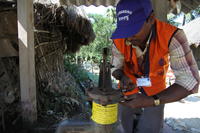Water for People has helped Sagar and Patharpratima boost coverage and improve sustainability.
Published on: 11/11/2013
 The NGO Water for People has helped the administrative blocks of Sagar and Patharpratima to boost coverage and improve sustainability. Triple-S looks at success factors and possible obstacles to continued progress.
The NGO Water for People has helped the administrative blocks of Sagar and Patharpratima to boost coverage and improve sustainability. Triple-S looks at success factors and possible obstacles to continued progress.
Since 2006, Water For People has been concentrating its efforts in West Bengal with the goal of achieving full coverage in two administrative ‘blocks’: Sagar and Patharpratima – groups of islands in the Sundarban area. The NGO had been concerned about sustainability from the outset but began to increase its focus on the issue around 2010, after realising that many water committees were not performing and that a large percentage of water points were not functional.
To improve the likelihood that installed or rehabilitated water points would remain in good working order, Water For People began to address some of the gaps in local service provision arrangements. This work centred on ensuring functioning water-user committees capable of collecting tariffs and undertaking maintenance and simple repairs, and establishing a network of handpump mechanics to carry out more technically demanding tasks.
Both blocks can be considered islands of success, having achieved high levels of coverage at scale. In Sagar, full coverage has all but been achieved, and in Patharpratima, coverage is around 80% – representing a 5% coverage gain.
There has been progress on sustainability, as witnessed in improved non-functionality rates. Overall non-functionality is down to 18% (from 30-40% before the intervention) in the two blocks. For the water points, where Water For People directly intervened, non-functionality is down to 5%.
To learn more, download the full report and a short case study from the links below.